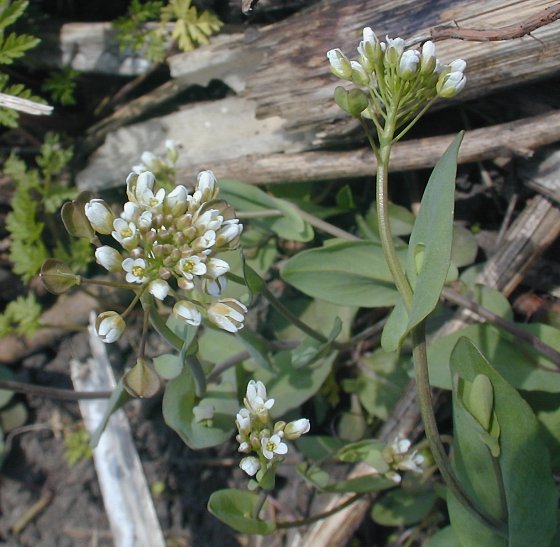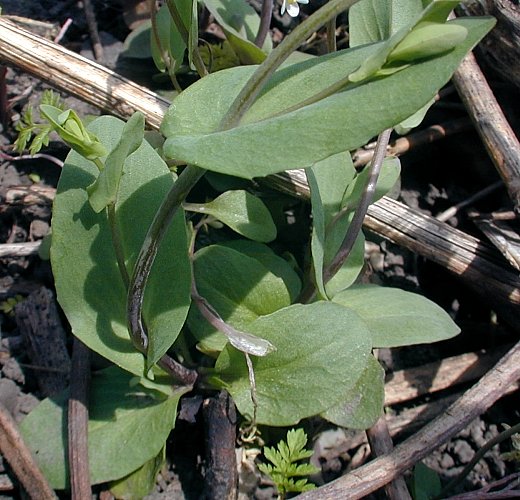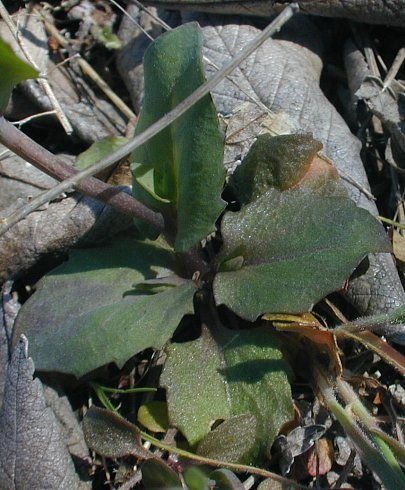Description: This plant is a winter annual that becomes ½–1' tall, branching occasionally. It overwinters as a low rosette of basal leaves about 3" across. These basal leaves are oval-cordate, hairless, and dentate along their margins. During the spring, one or more flowering stems with alternate leaves are produced. These stems are round, hairless, and light green to purplish green. The alternate leaves are up to 1½" long and ½" across. They are lanceolate-oblong or broadly lanceolate-oblong, hairless, and slightly dentate along the margins. The base of each alternate leaf clasps the stem with rounded basal lobes. The upper stems terminate in racemes of flowers about 2-4" long. Each raceme has whorls of small white flowers near its apex and silicles (flattened orbicular seedpods) at various stages of maturity below.

Each flower is about 1/6" (4 mm.) long, consisting of 4 white petals, 4 greenish purple sepals, several stamens, and a pistil. The flowers are often reluctant to open. The blooming period occurs from mid- to late spring and lasts about 1 month. There is no noticeable floral scent. Each flower is replaced by a silicle about ¼" long and a little less across. This silicle is notched at its apex where there is a pair of narrow membranous wings. It is hairless and often slightly concave on the upper/inner side. The silicles (or flowers) have spreading pedicels that are about 1/3" (8 mm.) long. The 2 cells of each silicle have several small seeds that are yellowish brown and smooth across the surface. The root system consists of a taproot. This plant spreads by reseeding itself, and occasionally forms colonies. The silicles can be blown about in the wind, helping to spread the seeds into new areas.

Cultivation:
This
plant is found in light shade to full sun, moist to slightly dry
conditions, and various kinds of soil, especially if it is lacking in
fertility, as this reduces competition from other species of plants.
Most vegetative growth occurs during the early spring.
Range & Habitat:
The adventive Perfoliate Pennycress is a rare plant that occurs in only
a few counties of east-central Illinois (see Distribution
Map). It is native to Eurasia. Habitats include fields, areas
along railroads and roadsides, semi-shaded fence rows, and waste areas.
Disturbed habitats with scant vegetation are strongly preferred.

Faunal
Associations:
Not much is known about the floral-faunal relationships of this
species, but they are probably similar to those of the more common Thlaspi arvense
(Field Pennycress). The small white flowers probably attract small
bees and flower flies, although such visitors appear to be relatively
uncommon. The caterpillars of polyphagous White butterflies and some
moth caterpillars may feed on the foliage occasionally.
Photographic Location:
Along a little-used railroad track in Urbana, Illinois.

Comments: This is an uncommon little weed. It is a member of a large group of plants in the Mustard family that has racemes of small white flowers and flattened round seedpods called "silicles." What sets the Thlaspi spp. (Pennycresses) apart from other members of this group are the relatively large size of their silicles. In Illinois, there are only two Pennycresses: Thlaspi perfoliatum (Perfoliate Pennycress) and Thlaspi arvense (Field Pennycress). The latter is a more common and robust plant with silicles up to ½" (12 mm.) long, while the silicles of Perfoliate Pennycress are about ¼" (6 mm.) in length. Other members of this group of plants have silicles about 1/6" (4 mm.) long or less. Field Pennycress has orange-brown to black seeds with concentric ridges (at least 2 mm. in length), while Perfoliate Pennycress has yellowish brown seeds with a smooth surface (no more than 1.5 mm. in length).